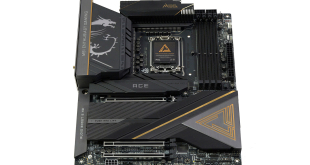So far, we’ve only seen motherboards with a single Thunderbolt port, but Gigabyte’s new GA-Z77X-UP4 TH is the first motherboard to sport a pair of the high-speed ports. However, there’s much more to this new motherboard than Thunderbolt connectivity, so let’s take a closer look at what’s on offer.
The Z77X-UP4 TH is a mid-range board in Gigabyte’s line-up, despite the Thunderbolt connectivity and as far as we’re aware, there should be one model up and one model down with Thunderbolt connectivity, but we should find out about that later today when we head over for a visit to Gigabyte’s show room in the Taipei 101, as the board we looked at was shown to us ahead of the show.
The slot configuration consists of three x16 PCI Express 3.0 slots in a x16/0/0, x8/x8/0, x8/x4/x4 configuration as long as you have an Ivy Bridge CPU. With a Sandy Bridge chip you end up losing the bottom x16 slot as is quite often the case on Z77 motherboards. Moving on we have three x1 PCI Express slots of which two are accessible unless you’ve got a graphics card with triple-width cooler and finally a PCI slot.
We were somewhat disappointed by the fact that Gigabyte hasn’t included any additional SATA ports beyond the six provided by the Intel chipset.
This is the first motherboard from Gigabyte this high up in its product range to not feature additional storage controllers since Gigabyte implemented its current naming scheme which goes all the way back to the 965P chipset. The board does sport an mSATA port, but this is shared with one of the SATA 3Gbps ports.
As with the Z77X-UP7, the Z77X-UP4 TH features IR’s PowIRstage’s, although here we’re looking at a simpler configuration with a different type of chokes, although we’re not entirely sure as to how many power phases the board has. As you can see, Gigabyte has also re-designed its heatsinks and although the ones for the PWM area really are just for looks, we think this is an improvement on the heatsinks on Gigabyte’s earlier 7-series boards.
Also note the dedicated power regulation for the Thunderbolt controller which is located just below the Thunderbolt silk screening on the board.
This is something we haven’t seen on the single port Thunderbolt boards, but presumably this has been done to be able to deliver sufficient power to both of the ports.
Around the rear we have a PS/2 port, six USB 3.0 ports, Gigabit Ethernet, 7.1-channel audio with S/PDIF out, the two Thunderbolt/mini DP connectors as well as a D-sub, DVI and HDMI port. Note that thanks to the two Thunderbolt ports, this board can be used with up to three displays using Intel’s integrated graphics and it’s as far as we’re aware the first board to offer this feature. Admittedly two of the displays would be limited to 1920×1200, but this is still one more display than your average Z77 board.
So far it looks like Gigabyte has the best solution for those looking at getting some Thunderbolt connectivity for their desktop system, however we’re not sure the additional cost is going to make it a widely accepted standard for quite some time. Hopefully Intel will come to its senses and make Thunderbolt an open standard, but as long as the company can charge in the region of US$15 per chip, we can’t really see this happening.
Kitguru says: Dual Thunderbolt – Intel need to make this open standard
 KitGuru KitGuru.net – Tech News | Hardware News | Hardware Reviews | IOS | Mobile | Gaming | Graphics Cards
KitGuru KitGuru.net – Tech News | Hardware News | Hardware Reviews | IOS | Mobile | Gaming | Graphics Cards







One comment
Pingback: This morning at Computex it is ASUS in the spotlight - IT Lounge